As with the Helson Skindiver and the Steinhart Ocean Vintage Military, it is important to know the facts about the watch the Sharkmaster 1000 is based on, in order to have a full appreciation and understanding of why Helson even bothered to make this watch. The story of the Omega Seamaster 1000 actually begins with the Omega Seamaster 600, colloquially referred to as the “PloProf” (Helson also makes an homage to this watch, not surprisingly called the Sharkmaster 600). For an extremely rich and in-depth history of the watch, I recommend visiting PloProf.com, as the tale of that watch can’t be fully fit into this review, but to give you an overview: the PloProf was developed in the mid 60’s by Omega, Comex and Jacques Coesteau, and released in 1970. The watch featured many unique technological advancements designed for the professional diver, such as a monobloc case, locking bi-directional bezel and locking crown. Visually speaking, the look of the watch is striking, bizarre and ungainly, even Omega ran ads saying, “It may not look pretty on the surface, but deep down it’s beautiful.”
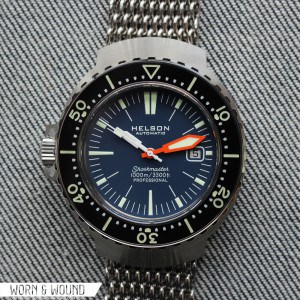 Case: 316L Stainless Steel Monobloc
Case: 316L Stainless Steel Monobloc
Movement: ETA 2824-2 25 Jewel Automatic w/ Date
Dial: Blue w/ White indexes
Lume: C3 Lume
Lens: Sapphire
Strap: Rubber Strap + Steel Mesh
Water Res.: 1,000m
Dimensions: 44mm, 54 lug-to-lug,
Thickness: 15mm
Lug Width: 22mm
Crown: 6.5mm screwdown
Weight: 200g on mesh
Warranty: 1 year
The Seamaster 1000, released in ’71 was a follow up to the 600 that took many of its aesthetic design features, dropped the extreme look, and wrapped them up into a “helmet” shaped case. Most notably, the dial, hands and bezel insert of the PloProf were ported directly into the 1000. The case is actually a monobloc adaptation of design Omega had used in the late 60’s on their extremely cool Flightmaster Chronograph. In some ways, the design of the Seamaster 1000 seems to have been intended as a more consumer friendly variation of the PloProf, but by increasing the water resistance to 1000m, maintained its position as a pro diver. Though I haven’t been able to confirm this detail, I have seen the Seamaster 1000 referred to as the first 1000m rated dive watch.
True to form, Helson stayed very faithful to the original design, as such reviewing the Sharkmaster 1000 is like reviewing a watch by 2 brands. The design is attributed to Omega and the r&d teams that worked on the original watch, while the execution and quality of the homage goes to Helson. For the sake of not writing the world’s most confusing review, I will just talk about the watch plainly, but keep in mind, as with any homage watch, that multiple parties should get credit. Now on to the watch…
Case
The 316L stainless steel case of the Sharkmaster 1000 is truly an object to behold. Measuring 44mm in diameter, 54mm lug-to-lug, 15mm tall and weighing 150g, the monobloc case is as massive as it is unique. From overhead the design looks simple: there is an oval that runs tangent to the large bezel, elongating only slightly as it reaches the lugs, that shape is then intersected by a rectangular form with rounded sides that creates the hooded lugs. On the left side, at 9, is the screw-down crown, which is flanked by crown guards. The guards jut out of the case with almost no transitional curvature, creating a very sudden disruption to the flowing oval shape. However, since the crown is located at 9, it does not dig into your hand when wearing the watch.
Looking at the watch from the side, the true intricacy of the design begins to show. The whole case has a sort of pyramidal shape leading up to the 4.25mm thick bezel, with a gently arced underside. The top surface of the case not only tapers up, it is also arced around the central axis, giving the very chunky case a smooth, flowing top surface. The sides themselves are cut straight down, emphasizing the height of the watch. Turning the watch 90 degrees, one can see the deeply scalloped bottom edge. This detail is purely ergonomic, and while funky looking, is quite brilliant. While wearing the watch, the scalloped area hovers above the skin, and when one’s wrist is flexed, that negative space prevents the watchcase from sticking into one’s arm and hand. Though I think it lends the watch to being a bit top heavy, the increase in comfort is obvious.
 The underside of the watch has no markings, but rather a simple ribbing pattern. These grooves, which traverse the underside, help lessen direct contact between the case and one’s arm, allowing for air and moisture to pass through; a subtle but brilliant ergonomic design feature. The 22mm hooded lugs are thick walled and spacious, allowing for easy strap changing. Helson numbers their watches, and on the Sharkmaster 1000, this number is located on the underside of one of the hoods, making it only visible when the watch is strapless.
The underside of the watch has no markings, but rather a simple ribbing pattern. These grooves, which traverse the underside, help lessen direct contact between the case and one’s arm, allowing for air and moisture to pass through; a subtle but brilliant ergonomic design feature. The 22mm hooded lugs are thick walled and spacious, allowing for easy strap changing. Helson numbers their watches, and on the Sharkmaster 1000, this number is located on the underside of one of the hoods, making it only visible when the watch is strapless.
Though I can’t compare it to the original, I can certainly say the Helson did a great job on the machining of this case. As you can tell from the images and the description, the geometry of the monobloc case is quite complicated, with various intersecting forms, angle changes, crevices, etc… The edges all around are crisp, corners are sharp and the finishing is even throughout.
Dial, Bezel + Hands
The dial of the Sharkmaster 1000 model I received is a medium blue color that has a hint of teal in it, with a black text on silver date wheel. It’s a very attractive color that softens the overall feel of the watch, which is welcome given its overall size and strong geometry. The dial has a primary lumed, non-numerical index consisting of slightly tapered rectangles for the hours. At 12, there is a double hash mark, giving more weight to the top of the dial. Between the larger hour markers are non-lumed thin white lines for the individual minutes, as well as thin lines extending the hour markers in towards the center. While the index is busy, it is well balanced and very nicely designed. At 3 is a date window that is outlined in white, showing the silver wheel underneath. The silver works well with the blue of the dial, neither standing out too sharply nor being hard to see. Overall, it’s a really attractive dial design that feels contemporary and is different than other dive watch standards, having somewhat smaller markings.
The bezel insert, conversely, has a much more 60’s/70’s look, featuring a black acrylic insert with various markings in both C3 and white. At 0/60 there is a lumed outline of a triangle. For minutes 5, 15, 25, 35, 45 and 55, there a tall thin lumed lines, and at 10, 20, etc… are full numerals. The individual minutes are marked in small white “home base” shaped markers that point in towards the dial. The fonts, line styles and marker shapes all feel somewhat dated, but in a good way, as the somewhat softer design contrasts with the dial well. The bezel is also very well constructed, with a 120-click uni-directional mechanism that has a very substantial and satisfying click. The steel sides of the bezel, which is relatively tall, have fairly deep and wide grooves, creating an easy surface to grab.
 The hands of the Sharkmaster 1000 are in the iconic “plongeur” style, taken from its predecessor, the PloProf. This style is defined by the oversized roman sword-style orange minute hand, small fence post shaped white hour hand, and a slender seconds hand with a lumed box. Obviously, it is a design that is made to emphasize legibility of the minute hand. It is also a very striking and aggressive look that has made it a go-to standard for dive watches. The bright orange of the minute hand works very well with the blue of the dial and the black of the bezel, creating a harmonious color scheme.
The hands of the Sharkmaster 1000 are in the iconic “plongeur” style, taken from its predecessor, the PloProf. This style is defined by the oversized roman sword-style orange minute hand, small fence post shaped white hour hand, and a slender seconds hand with a lumed box. Obviously, it is a design that is made to emphasize legibility of the minute hand. It is also a very striking and aggressive look that has made it a go-to standard for dive watches. The bright orange of the minute hand works very well with the blue of the dial and the black of the bezel, creating a harmonious color scheme.
As with other Helsons we’ve encountered, the Sharkmaster has very well applied and strong C3 lume. It picks up charge quickly, and stays charged for a decent amount of time, glowing very brightly at its peak. The application of the lume is very even, though the hands do seem to glow brightest.
Straps + Wearability
The Sharkmaster 1000 comes with 2 straps: a stainless steel mesh and an IsoFrane style rubber strap. The 22mm mesh is built to last. At 4.25mm thick, it certainly is a substantial bracelet, yet due to the chainmail construction, it does not add a terrible amount of weight. Furthermore, the mesh is quite flexible and comfortable against the skin. On the watch, it adds a consistency to the look, extending the oversized steel case around the wrist, as well adding a touch of refinement, as metal bracelets tend to do. Personally, this has been my preferred strap for the watch as the added rigidity of the mesh helps stabilize the heavy watch on my wrist. One thing to note is that this is not the type of mesh with removable or adjustable links. It’s basically one-size fits all, save the extension piece, which adds about 15mm to the total length. I have a relatively small wrist, at 7in, and I found the bracelet fit me perfectly out of the box. Not sure if the larger wristed would be in luck. The mesh comes fitted with seatbelt like clasp, and comes packed with a more standard deployment as an option.
 The IsoFrane style rubber strap is soft, smells good (like cocoa butter, I believe) and quite comfortable. If you’ve ever seen one of these straps before, which I bet you have, then there is nothing surprising about what you get. It’s a very durable strap that allows for water to pass easily through. It’s very long, allowing for a diving suit to fit under… It’s a standard in diving for obvious reasons. It also adds a rugged look to the watch that is very appealing. That being said, I find it less comfortable on the Sharkmaster do to the weight. The softness of the strap allows the watch to shift around a bit more than I like.
The IsoFrane style rubber strap is soft, smells good (like cocoa butter, I believe) and quite comfortable. If you’ve ever seen one of these straps before, which I bet you have, then there is nothing surprising about what you get. It’s a very durable strap that allows for water to pass easily through. It’s very long, allowing for a diving suit to fit under… It’s a standard in diving for obvious reasons. It also adds a rugged look to the watch that is very appealing. That being said, I find it less comfortable on the Sharkmaster do to the weight. The softness of the strap allows the watch to shift around a bit more than I like.
Ultimately, the combo of the straps is exactly what you want it to come with; something nicer for day-to-day wear, and something sporty for being active, or if you prefer that look. While I have not tried it on a leather strap, as I don’t have one particularly suited to watch, I could imagine the right brown really bringing out the color in the dial and hands. Wearing the Sharkmaster 1000 is a bit of an experience. It’s a very large watch, one that you will continually notice on your wrist. That being said, the 44mm case is tolerable and the 54mm length is just under too-big. The size is really aided by the ergonomic features that were designed into the monobloc case. The crown doesn’t poke you, the lower edges don’t cut into your flesh, and the arced bottom hugs your wrist, allowing the watch to grip. While it’s not the most comfortable watch to wear, it was never really meant as a daily watch. Looks wise, it is gorgeous and unique. No other watch in your collection is likely to have the same presence as this tank does.
In the Sharkmaster 1000, Helson has brought their A-game in creating physically accurate homages that don’t just look like the watch, but are actually high-functioning well-built machines. The detailing is superb, the build is without reproach, and with components like an ETA 2824-2 and a 4.5mm thick sapphire crystal, you know this watch is going to last. Coming standard with 2 quality straps, a spring-bar tool and extra spring-bars, there is no lack of value in the $899 this watch runs. From a practicability standpoint, this is probably not the ideal watch to get as your only watch, or only dive watch. But if you are interested in 70’s divers, vintage Omega divers or just big and gnarly watches, this is definitely one to consider.
review watch provided by Helson
by Zach Weiss









 Featured Videos
Featured Videos




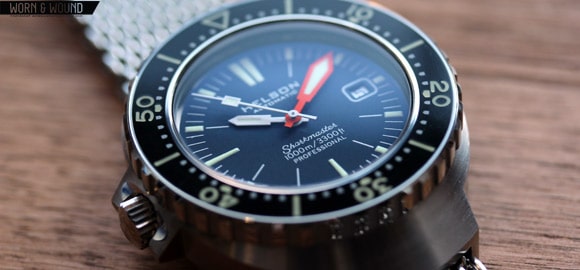
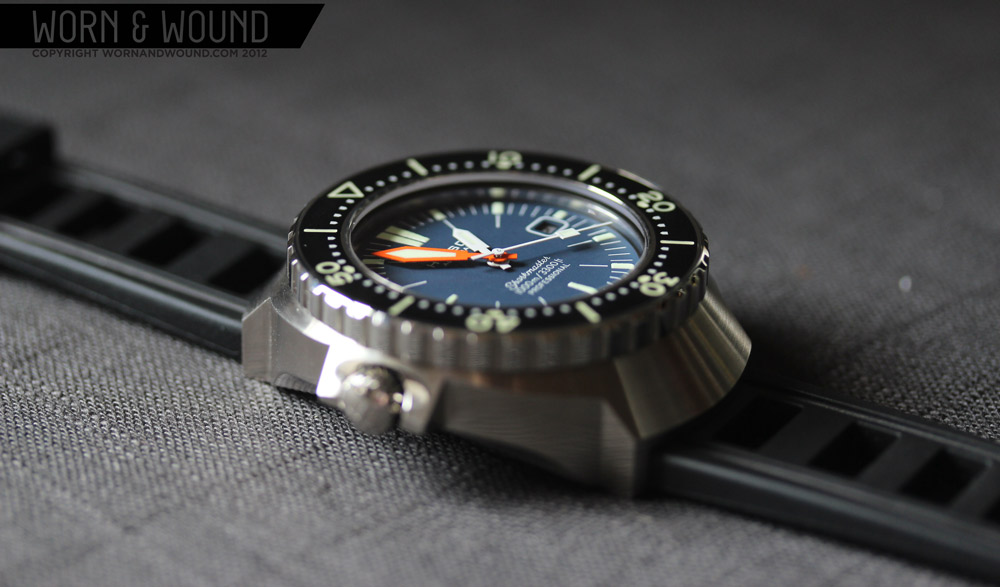
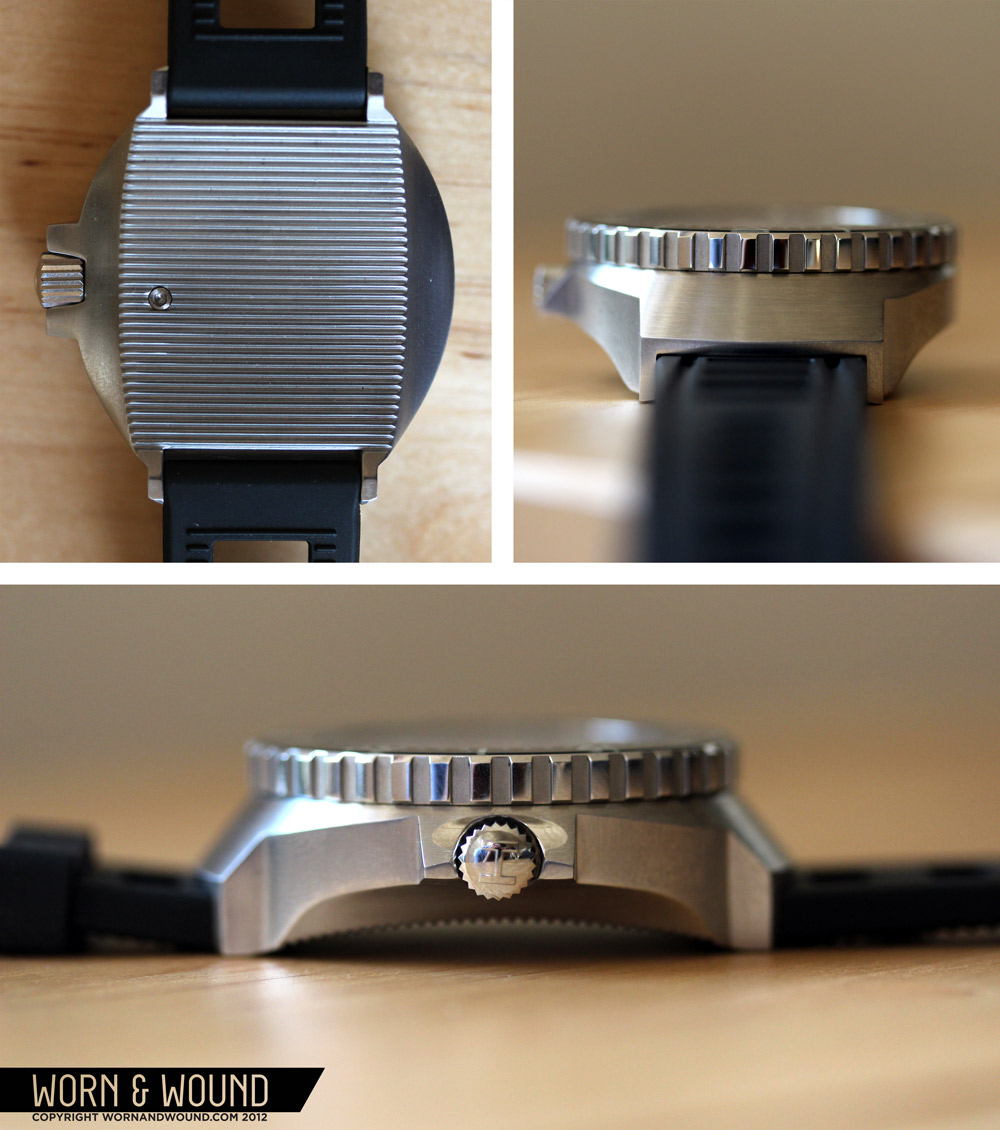
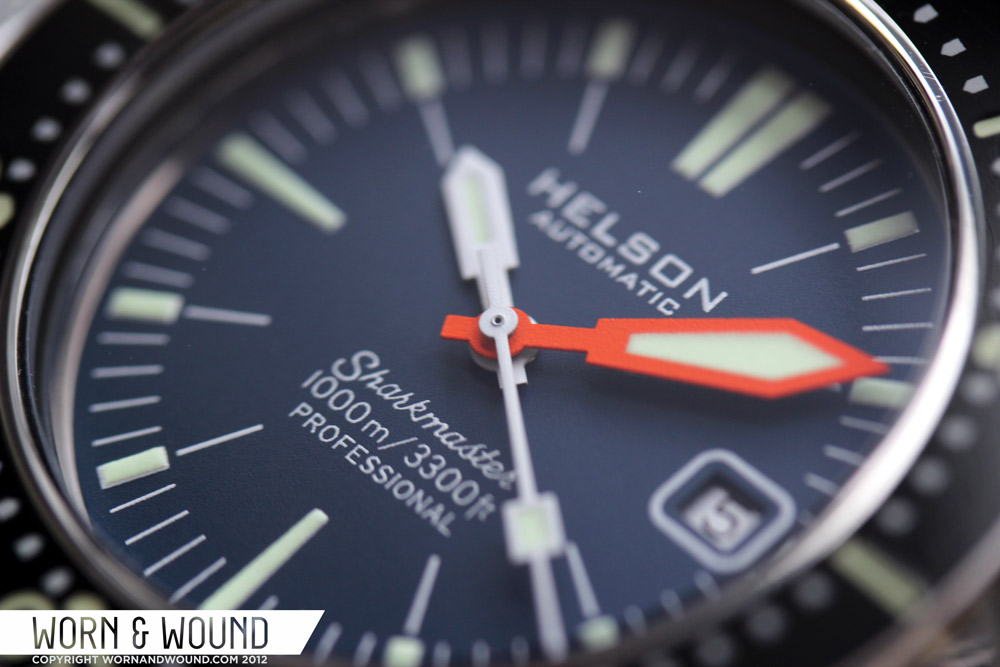
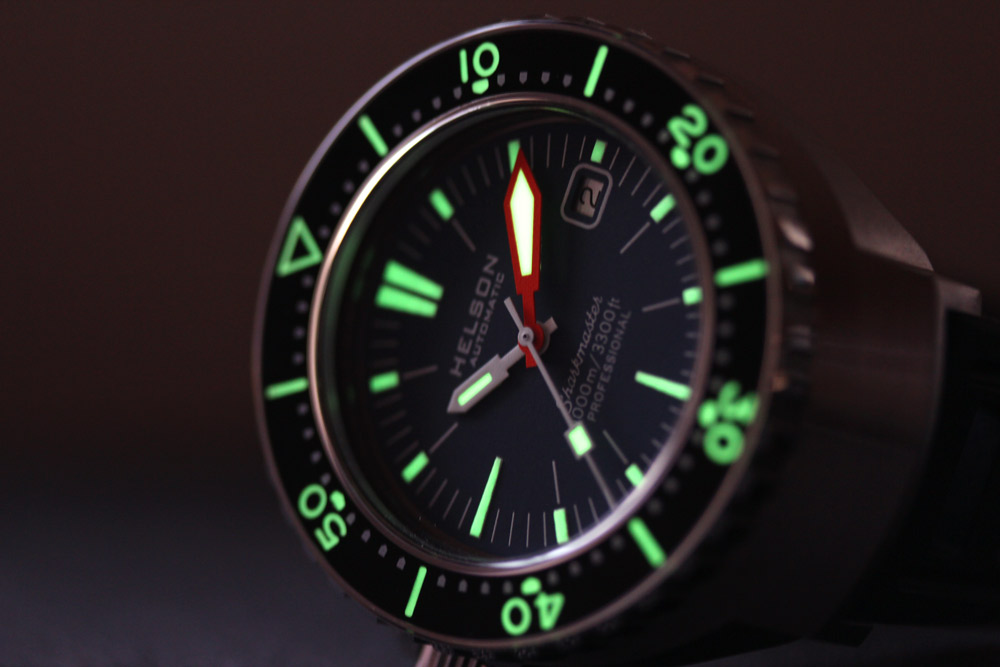
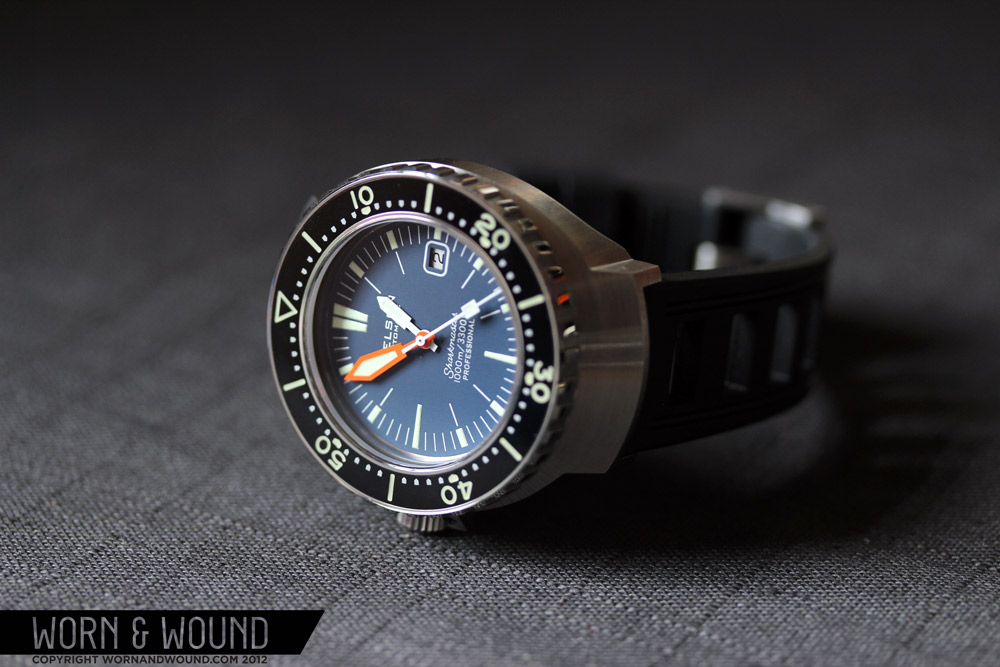
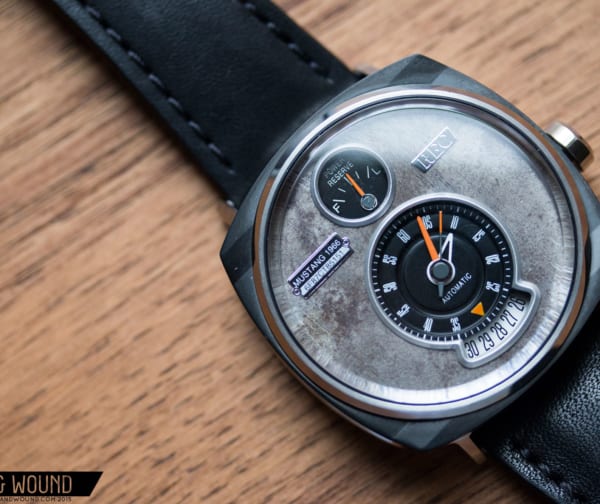
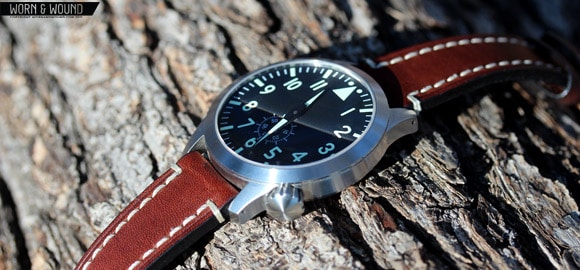

Fantastic review and pics!
Thanks Speedmaster!
Excellent read.i own 3 Sharkmasters 2,600s and 1,1000.have to agree the build quality,wareability and look of these watches is second to none.and all only done in small batches